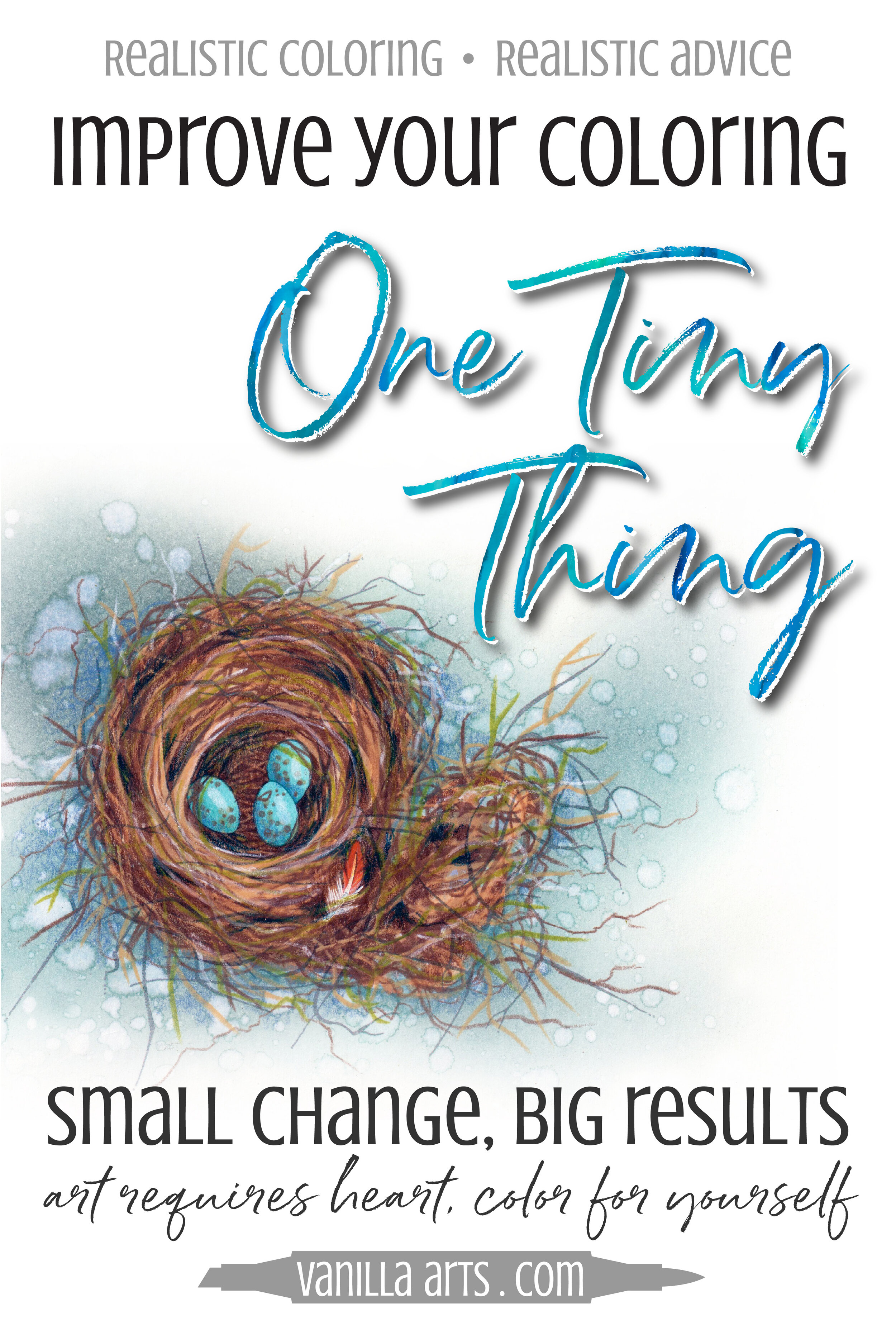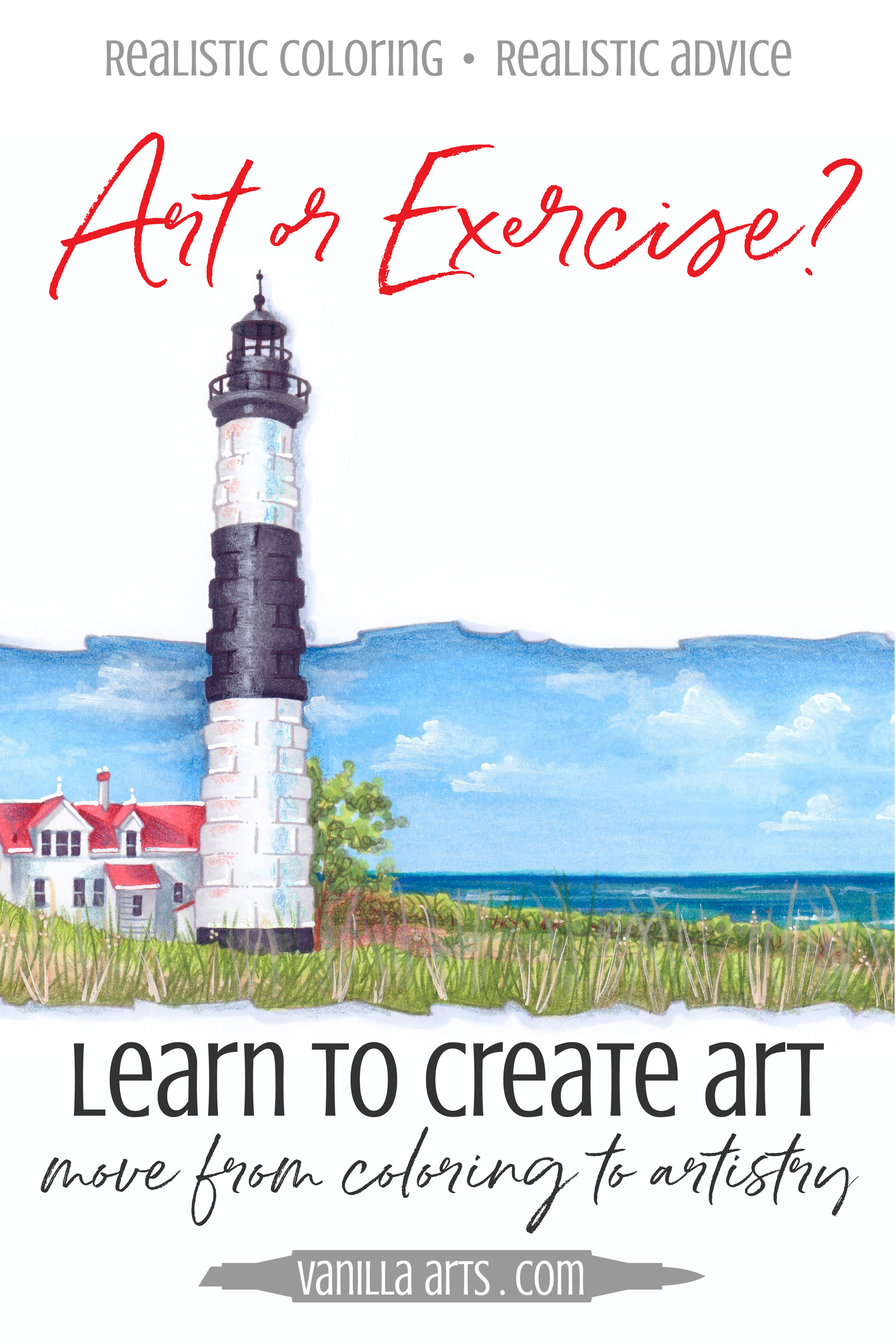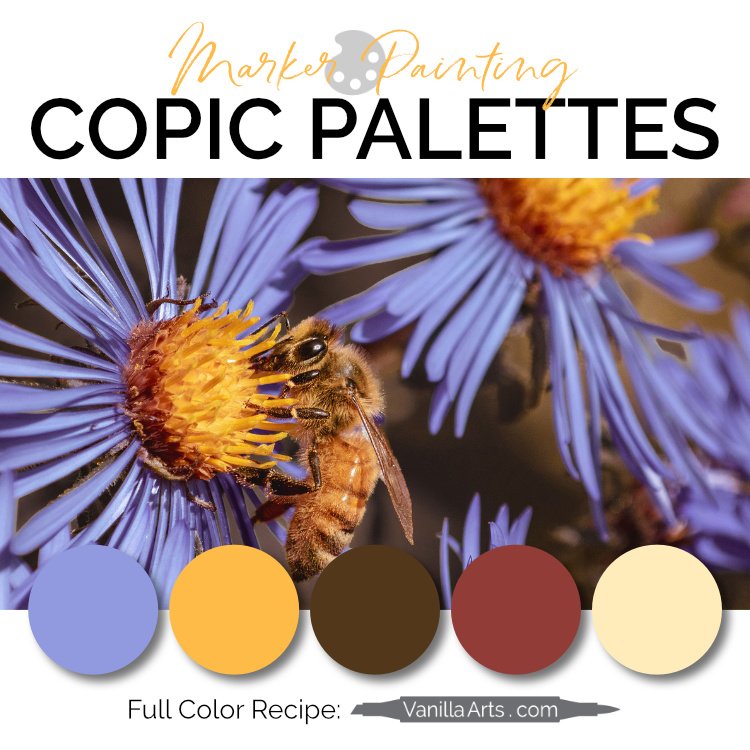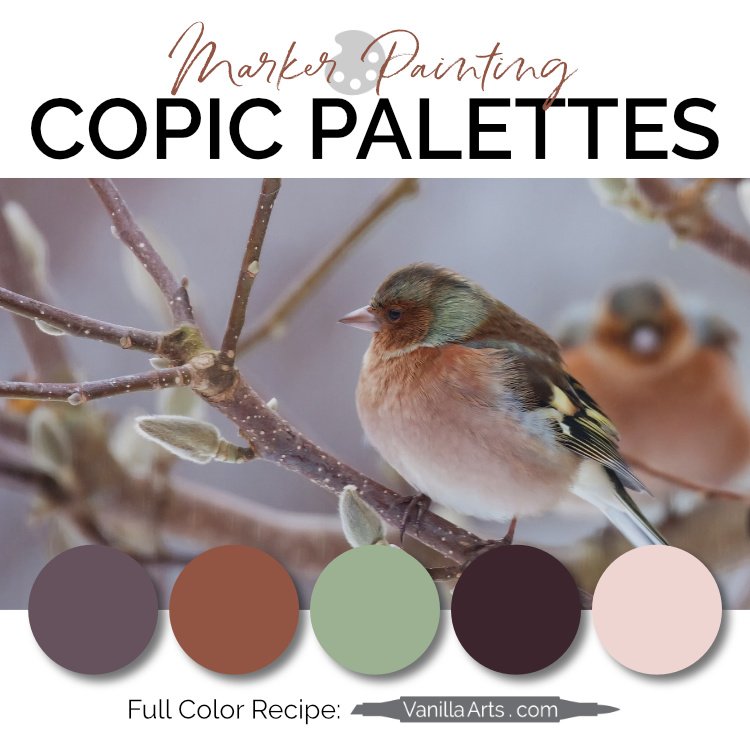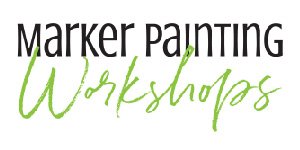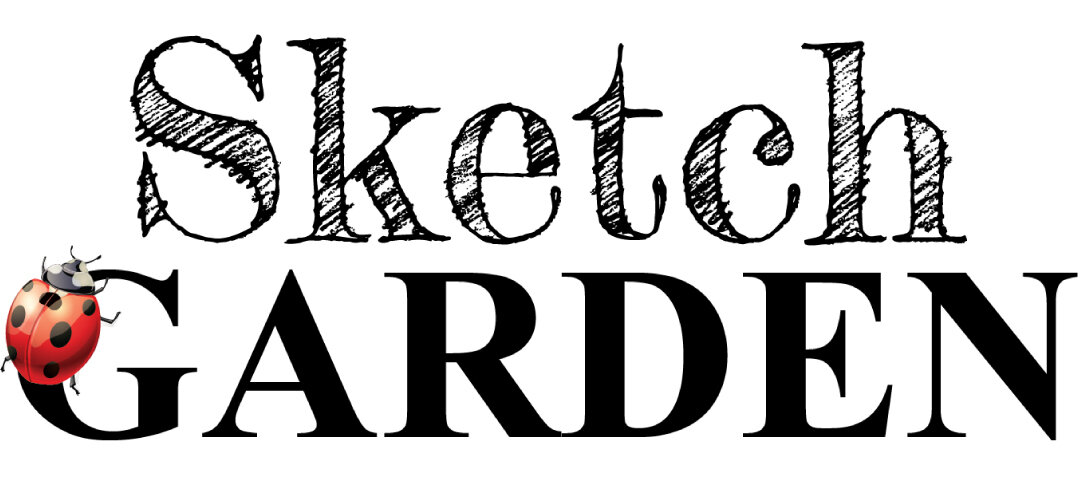Art versus Exercise: Are Copic Tutorial Projects Considered Art?
I’m amazed by my students!
And while I’d love to hog all the credit and boast that I’m an amazing teacher who can turn complete schlubs into Rembrandts… that’s not true.
Coloring has reached a whole new level. Copic Markers and colored pencils are not just a goofy hobby, people are learning to make art!
The fact is that there are some really talented people out there who work 9 to 5 jobs as dentists, accountants, and bus drivers. If you’re reading this, you’re likely…
The Secret to Amazing Coloring (Copic Marker, Colored Pencil)
Are you a fixer?
Readers of my weekly Vanilla Beans newsletters (subscribe here) have heard me mention the fixing process in the last two issues.
Yes, I’m a fixer.
But so is every other professional artist I know.
Fixing flaws, making adjustments, and making corrections is part of the artistic process. Nobody throws paint at a canvas and calls it perfect.
Artists labor over their artwork. Sometimes the adjustments are major, like adding a tree to balance the composition or painting over something that detracts from the focal point.
But the vast majority of fixes are so minor that you’d hardly even notice them.
I’m constantly fiddling with the temperature of things. I’ll add warm colors over the top of an object when it feels too cool (because cool colors tend to recede and feel far away). And I’ll cool something off when it feels too bright and boisterous.
I play with depth too. I push things deeper by adding more dark, desaturated colors or I’ll pull them forward by lightening and brightening certain areas. I almost never get depth right the first time, it’s a process rather than a single step.
I also reshape things a lot, especially with botanicals. I’ll round off the edges of things or loosen up the outline if that’s what’s needed. I’m rarely happy with the original way that I draw anything; shapes always morph as I work my way through the project.
Wise people know that everything in life requires some form of adjustment.
Are you a color-it-once kind of person?
I hope not.
It’s the equivalent of a race car driver who refuses to pit for fuel or a singer who knows the microphone isn’t working but continues to sing softly anyway.
Who does that?
Colorers. That’s who.
There’s this weird mindset within the coloring community that coloring is a one-and-done process. Once you color an area, you’re done with it forever.
Wrong.
So wrong it makes my left eye twitch…
Trying to get everything right on the first pass? Wow, that’s a lot of pressure to put on yourself.
But I can’t blame you. Tutorials never seem to mention the “go back and fix that thing you just did wrong” part.
And coloring bloggers and video makers try to present themselves as amazingly awesome coloring super-stars, so the parts where they screw things up often gets edited out.
I guess I can’t fault folks for thinking that they’re not very good at coloring when almost every Copic colorer you’ve ever seen pretends that they do things right every time and every step of the way.
The truth is...
...the good stuff really only begins to take shape when you go back and perfect things.
In the beginning stages, you color on white paper. Your colors will change as you build up more and more intense color throughout the project. There’s no way to predict how strong something needs to be at the beginning of a project. You absolutely have to go back and make value adjustments later- it’s part of the coloring process
Shapes change as you color the spaces around them. I usually do floral leaves before I color the petals. I almost always have to go back and reshape the leaves, especially when they overlap a blossom. Refining shapes is part of the coloring process.
Sometimes a shape isn’t what we thought it was. I can’t tell you how many times I’ve colored something as background, only to find out later that it was actually a flower petal or a lock of hair. You can’t skip that kind of correction. Correction is part of the coloring process.
And lastly, sometimes I look back and realize that some of my blends look choppy. As you work your way through any project, your blending gets better and smoother as you get into the groove. So it’s natural that you may need to go back and smooth the first few things you colored.
Are you sensing a pattern here? Smoothing your blends is also a part of the coloring process.
And yet in the coloring community, no one wants to admit this stuff.
But artists? Hoo boy, we mess up all the time and most of us will gladly talk at length about all the corrections we make. We kind'a take pride in rescuing projects that were heading southward... "man, I fixed the heck out of that area over there!"
The difference between a mediocre artist and a great artist is that great artists fix and adjust the mediocre stuff until it looks great.
Fixes are essential to making great projects
I’m a better colorer for making these changes.
I’m an honest colorer for admitting that I do this. It serves no purpose to pretend that I got it right from the start. Hey world, I almost never get it right from the start!
So the next time you’re knee-deep into some online tutorial or internet video, don’t beat yourself up for not coloring it all perfectly.
There are steps missing from that tutorial. They are not showing you everything.
Correcting and adjusting… we all do it.
You should do it too.
It’s okay to go back and fix things. In fact, it’s vital that you go back and fix things.
What’s the secret to amazing coloring?
It’s as simple as going back and making adjustments.
Please Skip the Three Marker Challenge
Creative minds need to stay occupied
That whole "idle hands/devil's workshop" thing is pretty true when it comes to gifted people. Especially when creative adults congregate in small groups.
Back in art school, when we were young and convinced that we were the most talented geniuses to ever squat on this planet... well, we got bored pretty easily. Given that in one of our classes, we drew a single toaster for an entire semester (not kidding), you can understand why we started dumb challenges.
I'll bet you can't draw sixteen different dog breeds on this napkin in 4 minutes or less!
I'll bet you can't draw an accurate likeness of Jane using just this sticky fragment of vine charcoal that I found in the trash!
I'll bet you can't recreate Vitruvian Man using only spaghetti noodles!
Yep, that's what art nerds do when they run out of real stuff to do.
So I smiled when the whole Three Marker Challenge thing on YouTube started trending. It's been a long time since anyone dared me to MacGyver a masterpiece using two rubberbands and a wad of C-4. It's fun to watch other artists have fun.
Stand-on-your-head, color blindfolded, use-your-feet, and here's a scribble, make something out of it challenges are the way artists bond with each other. Look what I can do. Hey, try this. Wouldn't it be funny if Mark had to...
The only thing that has changed about the art-challenge culture is that now the youngin's are publishing the antics on YouTube. That stuff used to happen in dorm hall dining rooms, not out in public.
Let me state for the record: I don't mind people posting hi-jinks online. I think it's great that artists can show off their talents, develop a fan base, AND supplement their income while having fun with their peers.
But I've started noticing a downside to the well mannered frivolity
When you follow an artist over a period of time on YouTube, by watching their process in slow-motion detail, a lot of people begin to think "Hey, what they do is sooooooo easy! I can do it too!"
Which can indeed be true. Maybe you really can color/draw/paint just like your favorite internet star.
But for the vast majority of viewers...
....how do I say this gently?
You can't.
You haven't spent long semesters drawing toasters. You haven't spent years in life drawing sessions sketching really homely naked people. You haven't trained and sweated and drawn until 4 in the morning and then still got a D on the project because the perspective was off just a smidge. You haven't worked for a jack-ass clients and demanding art directors.
Keep this in mind when you watch an artist make magic out of 3 highlighters on a piece of birch bark
You are watching a well trained and practiced person take their talents, skills, and vast knowledge base and make the most out of a crappy set of circumstances.
You're also watching an inside joke; one that you are not a part of. Just like weight lifters and surgeons, artists like to show off their skills by challenging established limitations. The lifter who presses the most weight, the surgeon who perfects the first head transplant, and the artist who figures out how to make Y99 plus RV02 look attractive- they all take victory laps in front of their peers.
I did it! Look at me! You didn't think it could be done but I showed you!
Beginning colorers should skip the crazy coloring challenges
Unless it's one of those color-every-day-for-a- month, week, or fortnight kind of challenges, please don't do it.
It is not for you.
I've seen two cases this month and I suspect this will be cropping up more and more.
Hey Facebook friends! I took the three marker challenge but I can't seem to get these markers to blend. Any tips?
Hello artists- I saw this online thing and tried it myself. What went wrong?
It takes 10,000 hours of practice to master a skill
Now I do not know about you, but I don't have a lot of free time to sit down and practice my Latin vocabulary or my blindfolded steeple chasing technique.
Time is precious. We have to ignore the dishes that need doing, put on kid-cancelling headphones, and hang a "YOU DISTURB, YOU DIE!!!" sign on the craft room door before we can log in any coloring practice time.
Productive Copic coloring time is a rare treat, so why would you waste it trying to color a seascape using E59, Y38, and YR000?
You learn what you practice
If the plan is to become famous for coloring with your feet, then by all means, take the challenge. Have at it.
But if you're still learning to color in the lines, to form basic blends, to color smoothly... you've got no business trying to do any of that stuff while standing on your head.
I know your coloring hero can do it, I've seen the video too. When you've practiced as much as she has, you'll be able to do it also.
But not right now.
You're not ready for it yet.
Would you ever strap rollerskates on toddler?
Nope. That's cruel. A baby deserves the chance to learn to walk on solid ground before you add wheels to the mix.
But it's okay for a nine year old to try roller skates. In fact, they might learn something from it. How to brace oneself for a fall, the importance of equilibrium. When you're a pro at walking, you can benefit from skating.
By the same token, Michael Phelps might gain something from swimming laps dragging a grand piano along side. That's because he has the muscle and the training and the know how to make the best of this seemingly impossible challenge.
When you watch someone really good try to color with three crazy markers, you can watch them go through the Michael Phelps piano process. At first, they struggle with the materials, then they get to know the colors and how they interact. Then they start thinking about what techniques they know to adjust the value, saturation, and interaction between the three inks. And sometimes their training or talent totally takes over and they conquer the marker combination. It's fun to watch that magic happen.
But that doesn't mean you can do the same thing with only a few months of marker experience.
As I said, there's something weird about the YouTube art experience...
You watch someone color twice and suddenly you feel like best friends. And best friends can do everything together, right?
And yet I doubt you will watch this video and suddenly start doing back flips off the side of parking structures.
And I'll bet you were able to watch a few episodes of The Apprentice without deciding to run for president.
Save the crazy coloring challenges for when you're fully grown
It's okay to be a coloring toddler. There's no shame in having beginner level skills.
In fact, I greatly admire the accountants, human resource managers, and engineers who take a look at Copic markers and say "I want to learn to do that".
Cradle yourself during this time of early learning. Don't be so quick to take on more than you can manage.
Don't strap a grand piano on your back when you barely know how to swim. Instead of impressing Michael Phelps, he'll be dragging you out of the pool with an ambulance crew watching.

